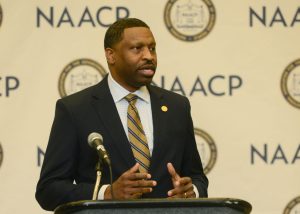William Alexander must be a pretty busy guy, what with running about 2,300 nonprofits, all out of 848 N. Rainbow Blvd., Suite 3078, in Las Vegas. So it would seem on paper, at least. Almost 2,300 small nonprofits from around the country now list William Alexander of “Non Profit Accounting Services” as their principal officer.
“I’m not sure why this is happening or whether someone’s exploiting identity theft,” said Bob Ottenhoff, president and CEO of GuideStar.org, which has operations in Williamsburg, Va., and Washington, D.C. The organization discovered the issue earlier this year when Vice President of Research Chuck McLean found 2,260 records all in care of the same person and address. He matched them against an Internal Revenue Service (IRS) list of organizations at risk of revocation and the vast majority of the nonprofits, but not all — about 2,029 of the 2,267 Ð were on the list. When GuideStar notified the IRS at the end of March, Ottenhoff said the agency told them they already knew about it. The IRS did not reply to inquiries for comment.
The IRS is good at the verification and review process at the time an organization is created but once tax-exempt status is granted, the IRS “does relatively little in terms of oversight,” Ottenhoff said. Last year’s Form 990-N process was a good first step to get the IRS’ database cleaner and more accurate, he said.
There was a big push last year by the IRS and the nonprofit sector to alert nonprofits that had not filed at least a Form 990-N postcard during the past three years. A change in federal regulations in 2006 required that all nonprofits file at least a Form 990-N, or e-postcard, every three years, so the IRS is aware it still exists, or purge dormant nonprofits from its files.
“In the meantime, as always has been the case, people (donors) should always be careful that they’re using the most up-to-date information, because the status of organizations can change from time to time,” Ottenhoff said.
It’s unclear when the IRS will publish its revocation list. Agency officials last year anticipated it would be ready by January or February. “That’s going to be a big deal,” Ottenhoff said, because it could affect 300,000 registered charities. Some expect the list could be published sometime in May.
GuideStar likely would have learned about the William Alexander situation eventually. “We’re always hitting one database off another. We would’ve begun to pick up on this over time, particularly when IRS releases the revoke list,” he said.
“It could be just a prank but there’s also existing nonprofit organizations that aren’t operating and sometimes people will acquire the shell for a very legitimate reason but I can imagine that some people would want those shells for very illegitimate reasons,” said Mark Fitzgibbons, vice president, corporate and legal affairs, at American Target Advertising in Manassas, Va. The worst-case scenario is that someone might use those shell organizations to solicit fraudulent donations, or it could be just some hackers doing a prank.
If someone was looking to start a fundraising scam, Ottenhoff questioned why they’d go to the trouble of grabbing 2,267 organizations and risk detecting a pattern rather than doing just a few. The IRS contracts with The Urban Institute to handle the Form 990-N processing and manage the website that organizations used for entering the information.
More than 400,000 Form 990-Ns were filed during 2010, according to Tom Pollak, senior research associate and program director at The Urban Institute’s National Center for Charitable Statistics in Washington, D.C. “In that context, while significant, one can argue that 2,000 in a one-time instance is not pervasive,” he said. It’s unclear whether someone could create a program to “robo-file” nearly 2,300 returns but Pollak assumed they were done manually.
“The IRS did a reasonable effort to balance the need to make it easy for small organizations to let them know they are in existence but, in doing so, this is always a possibility, unless they’d spent taxpayers’ money to develop some sort of system that provides extra levels of security,” Pollak said.
Much of the information required to file a Form 990 — Employer Identification Number (EIN), name, address, etc. — is found in the public domain, Pollak said, adding that someone could also file a paper return for an organization as well as an electronic return. There is an email validation process to the electronic return he said but no “shared secret” as with a Form 1040 where individuals enter their previous year’s Adjusted Gross Income (AGI).
Donors have to be more vigilant and spend a little more time making sure where they give is a legitimate charity, Ottenhoff said, and this is another example of why nonprofits must be transparent and accountable. “That is ultimately you’re best defense. We’re now in an era of trust but verify,” he said.
“That’s where I think more of our concern is focused on these days. Just because you’ve got your IRS approval doesn’t necessarily mean you’re an active nonprofit — or a legitimate one,” Ottenhoff said.
The incident “exposes flaws in the current system which should not lead to tougher laws in the wrong direction. It should make regulators rethink what they do, rather than try to make it tougher,” said Fitzgibbons, a frequent critic of charity regulators. “Because the current system is so poorly run, I can see that someone would be able to go through 2,300 shells over the course of many years and never get caught,” said Fitzgibbons. “The current system punishes those trying to comply and lets the mischief makers and miscreants get by,” he said. NPT











